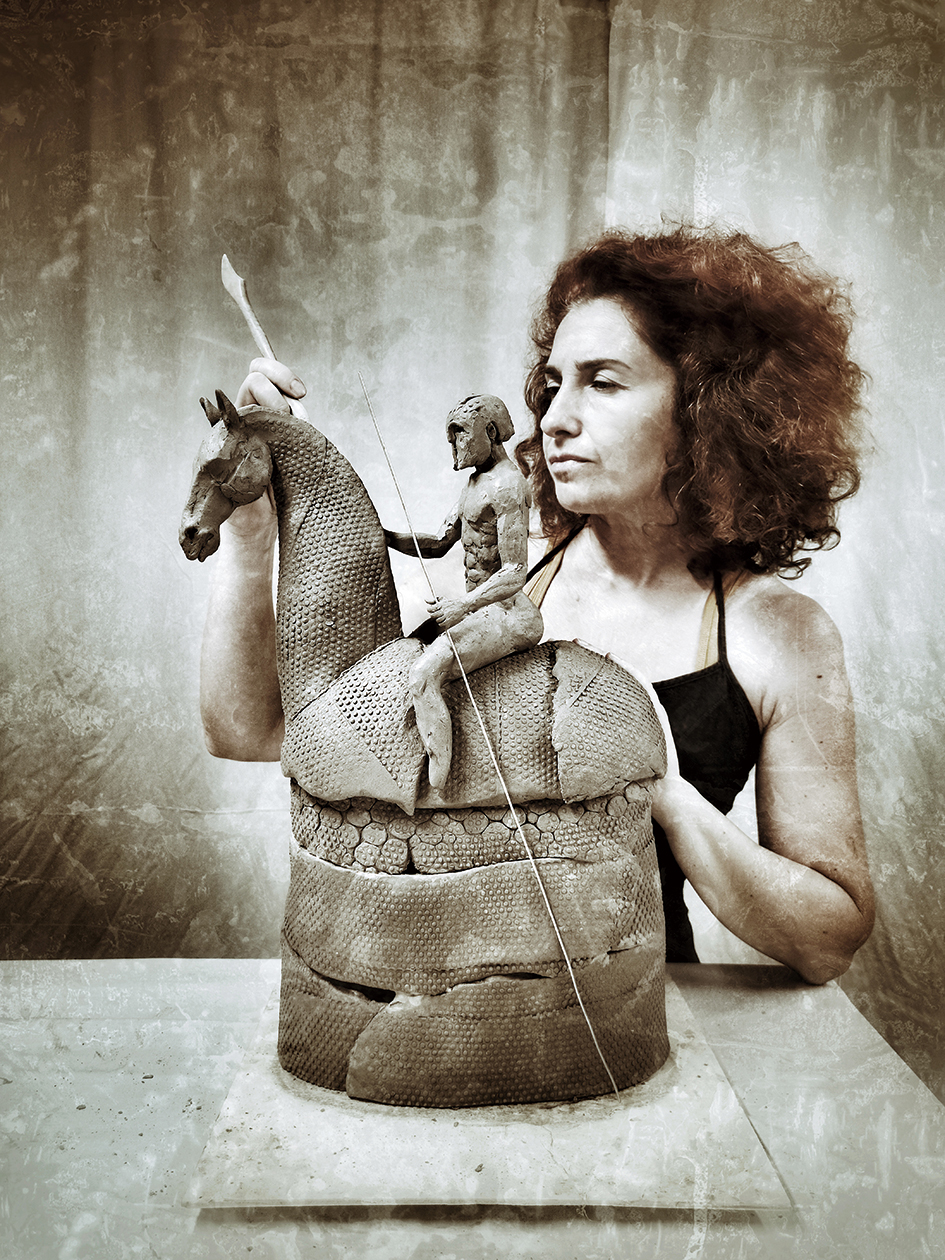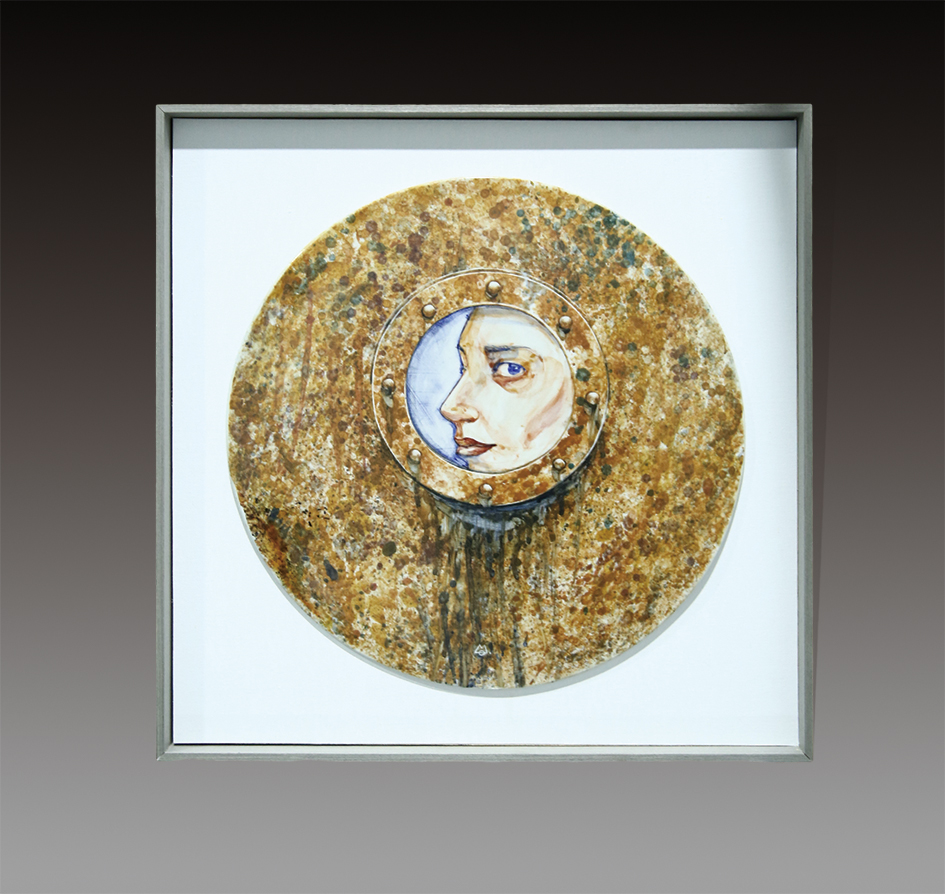
Merima Fetahović is a Serbian sculptor, a ceramist, and a member of the Union of Fine Arts Associations of Vojvodina. She has been working as an artist for many years and has held 14 solo exhibitions and more than 70 group exhibitions in Serbia, Italy, and other places. Her artwork has been widely acclaimed.

In the constellation of contemporary Serbian ceramic art, Merima Fetahović’s porcelain panel painting OBLÒ glows like a piece of amber crystallizing time. Framed within a circular composition, the silhouette of a woman’s profile becomes a visual fable transcending cultural boundaries. Dispensing with the tactile heaviness of clay, the ceramist constructs a profound spiritual field upon the flat porcelain surface through the fluidity of glaze and the translucence of porcelain itself, drawing viewers into a philosophical dialogue on gazing and being gazed upon within the round frame.
The work is sculptured on a circular porcelain panel approximately 56cm in diameter—a geometric form that carries dual semantic weight in visual art as a microcosmic projection of cosmic order and a metaphor for the boundary of intimate space. The woman’s profile is placed precisely at the vortex of this visual field. Beneath her slightly raised brow, her gaze reaches toward an unseen distance—an intentional composition that modernizes the window motif in traditional Balkan architecture design. In both the stained-glass windows of Serbian medieval monasteries and the latticed apertures of Ottoman-era dwellings, circular openings traditionally serve as spiritual conduits between sacred and secular, interior and exterior. Fetahović deconstructs these architectural signifiers, strips them of functionality, and transfers them as pure visual devices, thus turning the porcelain panel into a mediator of gaze suspended beyond time and space.
Unlike traditional ceramics, which rely heavily on the plasticity of clay, OBLÒ exploits the inherent qualities of porcelain painting. The material becomes a metaphor for the window—simultaneously translucent like a lattice and impenetrable like a wall. This duality echoes the artwork’s theme: gazing as a game of light and shadow, with porcelain’s permanence rendering the fleeting act of looking into an eternal gesture. In Serbian ceramic history, porcelain panels have long been seen as “pottery for the wall.” Fetahović breaks from this decorative convention and transforms the panel into a medium for philosophical reflection—compressing the historical memory of the Balkan Peninsula into a circular shard of fired earth, where the hardness of the material encases the fluidity of time.
The most compelling tension within this artwork lies in the bi-directionality of the gaze itself—when the viewer peers through the circular porcelain “window” at the depicted woman, her eyes seem to gaze back into the void beyond the panel. This reciprocal gaze deconstructs the “male gaze” tradition that pervades Western art history, where women are often portrayed as passive objects of vision. Here, while the figure maintains a seemingly passive posture, the subtle deflection of her eyes becomes an act of quiet resistance. Fetahović transforms the feminine gaze into a spiritual outlook toward the unknown, transcending gendered iconography to become a seeker within the existential dimension. In contemporary Serbian art, this articulation of female subjectivity holds profound resonance. Amid Balkan narratives marked by war and displacement, the feminine gaze is often seen as a covert force for preserving cultural memory. Fetahović, using porcelain as her medium, grants this intangible force a material presence.
The significance of OBLÒ in contemporary art lies in its demonstration of how traditional mediums can be reinterpreted in a modern context. Fetahović does not indulge in the ornamental patterns of Serbian ceramic tradition; instead, she draws from the spiritual essence of folk art to conceptually reconstruct motifs such as “window,” “gaze,” and “woman.” Within the seemingly conservative genre of porcelain painting, she conducts spatial experiments with circular compositions, employs layered glazes as psychological cues, and explores the philosophical implications of materiality—transforming ancient ceramic art into a vessel for articulating modern experiences. Her creative approach suggests that the contemporary regeneration of traditional culture lies not in replicating old forms but in reactivating their spirit. While Serbian artisans continue to debate traditional glaze formulas, Fetahović has already turned her gaze toward a broader field of cultural dialogue, elevating porcelain painting from a local craft to a cross-cultural visual language.
In this circular porcelain panel, we see not merely the profile of a woman but a nation’s act of self-reflection through an artistic medium. As her gaze penetrates the barrier of glazed porcelain and reaches toward an unknown time and space, it also invites the viewer to ponder: in an era where digital screens fragment our vision, can we still reclaim a gaze that is focused and profound? Fetahović uses porcelain as a mirror, and what we encounter before OBLÒ may well be ourselves fragmented by modernity.